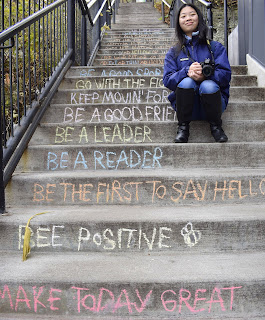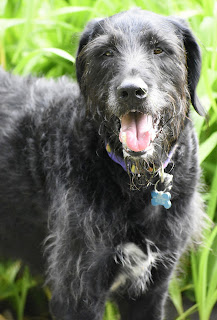A book that was recommended as part of the photography course I took last year was God is at Eye Level - Photography as a Healing Art by Jan Phillips.
There was a lot of good information and quotes as well as reflection activities to do. Below are some things I found most interesting in the book:
- Each snapshot was a story, calling on my imagination to fill it out, find my place in it, take my lesson from it.
- Many of us have the technical know-how and creative eye to shoot and print photographs every bit as stunning as those in galleries and photo books. The question is, are we doing it? Are we creating a body of work and putting it out there for people to see?
- No one in the world can make the same photograph of a person as I make, for the image my camera records reflects the relationship between me and the person on the other side of the lens.
- Each of us holds in our memory images that have affected us, changed our way of thinking, moved us to laughter, to tears, to action. Some of us are who we are today, doing what we are doing, because a photograph moved us in that direction.
- The root meaning of the word document is docere, "to teach." Whether we are documenting the evolution of our families or the revolution of a third-world country, the images we make are teaching tools.
- When we set out to document something, we are tasked with revealing the essence, the true spirit of it, as we see it and feel it in our bones.
- Photography heals because it reveals this essence within things. In the process of looking, finding, framing, shooting, all one's energies are focused purely.
- I'd photograph people, places, events that had meaning and joy I didn't want to lose sight of. Photographing meant I could keep an image to savor later, reflect on, find myself in when I was lost.
- As I improved in the craft, another voice came along, whispering, "Share this."
- There is no need to hold onto photographs that do not shed light, bring joy, tell a story, evoke an emotion, reveal a person's inner beauty, capture an important moment in time, or reflect a piece of the world that touches my heart.
- It is entirely up to me to throw photographs away if I am not satisfied with how well they meet my standards.
- Photographs provide evidence that our lives have meant something. They show our relationships with people, the places we've traveled, the events we've celebrated and honored. Of all the things that happen to us in the course of our lives, the most important get photographed. Photos are our autobiography, a way of telling the tale of who we are.
- What images are we gathering of events, large and small that mark the passage of our lives? How an we, as photographers, document the history of our families, our lives, our communities in a way that shows what matters to us, what forces bring us together?
- It is an easy thing to produce as a slide show of music, images, and words that portray the unfolding of a group's mission and values. Giving back to people a reflection of themselves in action, giving service, living out their faith or their commitments, is a tremendous gift. ANd it heals us to make these images, to place ourselves in the context of compassion and service, to bring to the table our gifts of visual discernment and delight.
- Like those who teach what they need to learn, we must photograph what we need to see.
- The healing aspect of photography is that it often leads us to those moments of togetherness, drawing us to those people whose spirit attracts us for some reason - and we come away with a picture of the kindness of people and the yearning that we all have to be truly seen by another.
- Include stories when you exhibit photographs. THey add breadth and dimension to a visual that can very well stand on its own. The stories we tell about our pictures can extend their reach, bring to light new ways of bridging the distance from one person to another.
QUOTES
- I have always taken pictures the way people keep journals and diaries. It's a way of ordering my reactions to the world, of placing my ideas and feelings in a concrete form outside myself, of breaking my isolation. (Diana Michener)
- Every creative person has a second date of birth, and one which is more important than the first: that on which he discovers what his true vocation is. (Brassai)
- Find something you like to do. Learn to do it well, and do it in the service of the people. (Karlene Faith)
- The ultimate aim of the quest must be neither release nor ecstasy for oneself, but the wisdom and power to serve others. (Joseph Campbell)
- The work of art which I do not make, none other will ever make it. (Simone Weil)
BOOKS TO READ
The Enduring Navaho - shows Laura Gilpin's photos when she was 77 years old.
RESOURCES
Syracuse Cultural Workers - syrculturalworkers.org
International Women's Writing Guild - iwwg.com
Creative Education Foundation - cef-cpsi.org
The Foundation for Women - foundationforwomen.org
REFLECTIONS/PHOTOGRAPHY ACTIVITIES TO DO
- Try to remember the activities you turned to as a child when you felt lonely and out-of-sorts. Do you do any of these things now? How have you replaced them?
- Make or find a photograph of something that calms you when you see it. Frame the photo and put it wherever you spend the most time in your day.
- Create a video with your best old and new family photographs. Put them to music and show it at your next family gathering.
- Imagine that you have one roll of film which to convey your response to an event in your life. Choose an event that carries some emotional weight. How do you represent these emotions in your images? What time of day would be most suitable? What colors come to mind? What objects?
- Select one of your favorite quotations and illustrate it photographically. When you review your photos, pick the one that works best, enlarge it, and create a poster with your image and the quotation.
- Study some of your favorite photographs. Try to figure out what it is about each that evokes strong feelings in you. Notice their design, texture, composition, color.
- Pick a subject that has some symbolic value, such as an old oak tree. Shoot it at different times of day and at different apertures.
- Take your camera on a trip and document the experience. Create a slideshow of your images so you can record and share your adventure.
- List three things or activities you feel passionate about (e.g., hiking or being out in nature). Choose one and develop a photo essay on some aspect of it. Expand your way of seeing. Look from the bottom up. Look through things. Look from the bird's point of view or the worm's.
- Plan a portrait day for your closest friends. Create a makeshift studio by putting a chair or stool in front of a white wall or a fence or patio door covered with a white sheet. Have your model sit in indirect light rather than in sunlight. Invite your guest to outfit themselves in a way that captures something essential about who they are and to bring whatever props they need to fill out the scene.
- Sort through your body of work and see if any underlying themes surface. What things do you tend to focus on when you photograph? What do your images say about what's going on in the world these days? About what's going on in you?
- What issues are being discussed in your local community? What images could you make that would reveal your opinion about these issues?
- What attracts your attention when you are in nature? How does it make you feel? Do photographs of these things help you capture that feeling?
- Imagine you have the chance to communicate something important about who you are to someone of great significance, but you can do this only through your photographs. If you had to select 20 images that would say what you wanted to say about who you are, what images would you use?
- Look at the photographs in your home, and see what stories they contain. What do you feel or think of when you pass by them? How do they serve you?
- Look at the photographs you have on your walls or altars. Take some time with each one to see what healing it offers you. How are you affected by those images?
- Sit down with a few of your photo albums and a wastebasket. As you go through the pages, remove all the photos that are blurry, too dark, too light, not quite right for some reason or another. Take a deep breath; then throw them away.
- Document the rituals that your family engages in - your waking hours, the preparation for school and work, the meals you share, the evening hours, the activities you do for fun and relaxation.
- Create a picture story called "One Square Block." Choose one block in your community and walk around that block during different times of the day just noticing what draws your eye. Photograph whatever is compelling. Consider enlarging and mounting your best images and hanging them in a bank or library or restaurant in your community.
- Take one of your favorite photographs and write the story that's behind it. Why did you take it? What did it mean to you? What else was going on at the time?
= Find a few images from your childhood that include you and some members of your family. When you are with those family members again, bring out the snapshots and ask each one to tell the story of what was going on for them on the day the photo was taken.
- Ask your children to write a story about themselves based on a few of their early photographs. Put these words and images together into a book, make a cover with a title and their name as the author, and present it to them as a present on some special occasion.
- Give some thought to what the "sacred" is in your life and to the spiritual truths that guide you on your path. Make a photo excursion and gather images that reflect this sense of sacredness and illustrate the essential oneness of all beings.















1 comment:
Lts to hear from that book and I love all your photos you included. :)
Post a Comment